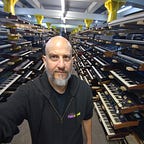10 Days. 10 Stories. Part 4–2013
Connected. Integrated. No time to waste, we hit the ground running in January 2013, assembled a fleet of ns-boxes for upcoming customer deployments and jumped straight into two very different projects.
We were asked to design and build a secure multi-site network for a gas pipeline surveillance application in Algeria. We can't really go into too many details about the solution due to client confidentiality agreements but what was interesting was that sites were located between 50km and 100km apart, requiring ultra long range SFP fiber modules. VLANs were trunked between sites, creating separate infrastructure management, data acquisition and operator access segments with host-based firewalls to filter IP traffic. The system is still in production today.
The day after we finished factory assembly and internal pre-acceptance testing we flew out to Abu Dhabi to install a data logistics solution in two different oil fields in the Arabian desert. This was the start of a 'trial by fire' and many important lessons were learned about extreme environments, civil engineering in desert conditions and how cross-functional communication between different departments is vital to ensure a successful outcome.
There a been a chronic lack of coordination between the primary end user client contact in HQ, our direct client (supplying the solution to the end user customer) and the oil field facilities prime contractor (and their subcontractors). It is dangerous to assume that component equipment (such as the ns-box) would somehow magically housed within an equipment shelter. We found out one week before the install date that the facilities contractor was expecting my direct client to provide a complete floor mounted enclosure solution. So we had to improvise. Fortunately the facilities contractor was able to fabricate frames from stainless steel T bar. Meanwhile we had to find a way to colocate the ns-box inside an existing instrument enclosure. Which at the time seemed like a good idea…
The kit was installed and commissioned on time. And everyone was happy until the beginning of the UAE summer, where the ambient temperature in the deserts goes above 55ºC. We learned a harsh lesson about thermal management and how easy it is to underestimate safety margins when designing a hardware product. When you install equipment in a stainless steel sealed enclosure, you don't have airflow and can only rely on conductive cooling. The original ns-box design didn't conduct enough heat away from the CPU and we destroyed 4 units in the field.
We went back to Abu Dhabi in August, the hottest month of the year. Outdoor work is severely restricted in midsummer and we were only able to work between dawn and midday, in 20 minute shifts with a 10 minute rest to cool off. We had leave our Land Cruiser's engine running with the air conditioning on full. We pulled out the ns-boxes and tried to improve things by adding a fan (brand name, Lucky Sky 😉). This worked up to a point, until the fans themselves overheated and died!
It took a lot of effort but we managed to radically improve the thermal efficiency of the ns-box by adding a machined aluminium block inside its enclosure which was mated to the CPU module using a special resin. This heatsink was itself mated to the outer enclosure. Problem solved!
We also improved the field installation by adding an customized fieldcloud ns-odu enclosure system with push-pull forced cooling. These were deployed inside the passively cooled shelters in the desert.
Meanwhile we were also hard at work with the revision 2 ns-box with redundant protection for all input/output interfaces (Ethernet, Serial, relays). We also switched to Greenliant SSD modules and added a high-temperature battery for the real time clock. All of these improvements were thanks to real world torture testing in the desert, which helped us build a tough, rugged product able to withstand extreme conditions.
We learned a lot in the field during 2013 which helped set the stage for even more interesting projects the following year!
10 Days. 10 Stories. A special feature celebrating fieldcloud’s adventure over the last decade and how we became the company we are today.
